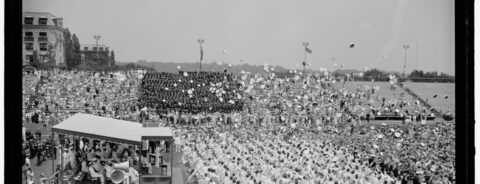 Ten American road trips In the spring of 1791, Thomas Jefferson and James Madison, accompanied by Jefferson’s enslaved chef James Hemings, took a road trip. In six weeks, they covered more than 900 miles, travelling through New York, Vermont, Massachusetts, and Connecticut before returning across Long Island. Suffering from various physical ailments and exhausted by the political travails of the day, they sought “health, recreation, and curiosity.” Madison said as long as they were together they could “never be out of their way.” Decades later, he recalled that the trip made them “immediate companions.” Few rites of passage are as venerated in American culture as the road trip, the journey of discovery to places unfamiliar or unknown. Here are ten noteworthy ones in literature and film in chronological order: 1. The Adventures of Huckleberry Finn (1884)Mark Twain knew about travel! In his famous novel, we follow Huck and Jim as they stream down the Mississippi in a biracial journey of discovery and escape. The trip gets a bit complicated in the novel’s third act, but, on the journey, they prove their manhood and confess their feelings for one another. Jim discovers he is free and Huck realizes the road is the only place for him. At the end, Huck continues his travels as he lights out for the Territory. 2. It Happened One Night (1934)In this classic screwball comedy, Clark Gable and Claudette Colbert find themselves together on a bus heading to New York from Florida. They hitchhike and encounter all kinds of difficulties as they fall in love, even though Colbert is married to a charlatan. Of course, they end up together. The film swept the key Academy Awards categories̶—and it did something else. In one scene, Clark Gable takes off his shirt to reveal he is wearing nothing beneath it. As a result, T-shirt sales in America plummeted. 3. The Grapes of Wrath (book 1939; film 1940)In John Steinbeck’s stirring novel, the Joad family, victims of the dust bowl and ruthless bankers, are forced to flee their Oklahoma home and head to California. They travel along the legendary Route 66, where they experience cruelty and kindness as they make their way to what they think will be the promised land. Unfortunately, it isn’t paradise, and at the end Tom Joad commits himself to forever travelling the country and serving as an agent of justice. “I’ll be everywhere,” he states. 4. On The Road (1957)Jack Kerouac’s novel is the one everyone thinks of when it comes to road trips. Much of the book focuses on the travels of Sal Paradise and Dean Moriarty. It is a tale of friendship and discovery, written in a stream of consciousness that matches the improvisational genius of jazz, which is a current that runs through the book. The novel has influenced generations of creative artists. Paradise says it best: “Nothing behind me, everything ahead of me, as is ever so on the road.” 5. Travels with Charley: In Search of America (1962)John Steinbeck makes this list twice. In 1960, aging and feeling that he had lost the feel for America, he embarked on a 10,000-mile journey across the nation, accompanied by his French poodle Charley. Part travelogue, part fiction, he wrote about the people he met. He gloried in the gifts of nature at Yellowstone and agonized over scenes of racial violence in New Orleans. In the end, he was uncertain what he found, and he lamented the loss of an older America. “The more I inspected this American image, the less sure I became of what it is.” 6. Easy Rider (1969)The film follows Captain America (Peter Fonda) and Billy (Dennis Hopper) as they travel by motorcycle from Los Angeles to New Orleans. The pair sold cocaine to finance their trip, and drugs, from marijuana to LSD, are part of their journey. In their travels, they experience life in a commune and befriend a lawyer (Jack Nicholson). But they face hostility (the lawyer is murdered) and, in the end, they are also killed. The movie defined an era where the rebellion of youth came to the forefront and the soundtrack forever linked rock ‘n’ roll to the journey on the road. 7. Zen and the Art of Motorcycle Maintenance (1974)Robert Pirsig’s book became a surprise bestseller, despite being rejected initially by dozens of publishers. It tells the fictionalized autobiographical story of a motorcycle trip he took with his son from Minnesota to California. Along the way, the narrative contemplates various philosophical and psychological issues. What the travelers found was inward, not outward. “Sometimes,” Pirsig writes, “it’s a little better to travel than arrive.” 8. Rain Man (1988)Awkward pairings are elemental in road narratives. Few are as different as the brothers Charlie and Ray, portrayed by Tom Cruise and Dustin Hoffman. One is an upscale collectibles dealer and the other is an institutionalized autistic savant. On their car journey from Cincinnati to Los Angeles, Charlie copes with the regimented habits of his brother and comes to appreciate and understand him. In Las Vegas, Ray uses his mathematical abilities to count cards and win big at blackjack. In the end, Ray returns to the institution where he lives, and Charlie promises to see him again, having come to appreciate his brother and realize he wants him in his life. 9. Thelma and Louise (1991)What starts as a girls’ weekend away becomes a one-way road trip to eternity. Geena Davis (Thelma) and Susan Sarandon (Louise), looking to escape from a domineering husband and deadening job, plan a weekend at a cabin. But after a stop at a roadhouse where Thelma is nearly raped and Louise kills her attacker, the women go on the lam. Along the way, their friendship and confidence grow, but they reach a point of no return as authorities bear down on them. They gas the engine and head toward a gorge. The film leaves the two of them in still frame, forever suspended in mid-air, pointed upward, out and away. 10. The Road (2006)In this famous post-apocalyptic work, Cormac McCarthy tells the story of a loving father and his young son journeying across a forbidding landscape. There is danger and horror everywhere and the pair struggle to survive. They strive to reach water, and do. But the father dies and the son is left to carry on with another family, who discover him. Father and son had “set out along the blacktop in the gunmetal light, shuffling through the ash, each the other’s world entire.” If each is the other’s world entire, it matters not where you are on the road. Feature image: Photo by Jaro Bielik on Unsplash. OUPblog - Academic insights for the thinking world. 
 The Naval Academy Class of 1940 [slideshow] As shocking as the Pearl Harbor attack had been for the Naval Academy Class of 1940, the sudden arrival of peace was nearly as disorienting. Most of the Forties, as they were known, were still only 27 years old, and the great adventure of their lives was now behind them. The war had dominated virtually all of their adult lives, from Hitler’s reoccupation of the Rhineland in 1936 to Japan’s surrender in 1945. For nine years, they had been directed by circumstance, authority, and a shared feeling of responsibility. They had served in different theaters, in different jobs, on different ships—or planes, or battalions. Yet all of them had been forged, tempered, and tested. Every man in the class knew someone who had been killed in the war, and the sacrifice of their classmates was etched into their hearts. They had learned to live in the moment; now they had to think of the future. For the next two decades and longer, they served in a wide variety of assignments throughout the world. For some of them, there was another war, in Korea. For a few, there was even a third war, in Vietnam. Throughout it all, they stayed in touch with one another, attended class reunions when they could, and caught the occasional Navy football game. Eventually, they retired. Some took up a new profession; several became teachers. But none of them ever forgot their trial by fire in the Second World War, nor did they forget one another. They were always Forties. [ See image gallery at blog.oup.com] Feature image credit: Graduation day at Annapolis, Class of 1940. Library of Congress, Prints & Photographs Division, photograph by Harris & Ewing, [reproduction number, e.g., LC-USZ62-12345]. Public domain. OUPblog - Academic insights for the thinking world. 
 10 books to read this Pride Month [reading list] Dive into ten remarkable books that illuminate the diverse and vibrant experiences of the LGBTQ+ community. From historical explorations that uncover the rich tapestry of LGBTQ+ history to biographies of influential musical figures who have shaped the cultural landscape, these books offer invaluable perspectives. Whether you’re looking to educate yourself, find inspiration, or simply enjoy compelling stories, these books are essential reads that honor and uplift LGBTQ+ voices. Choosing Love: What LGBTQ+ Christians Can Teach Us All About Relationships, Inclusion, and JusticeWhat does the battle between conservative Christians and LGBTQ+ people look like from the vantage point of those who are both? Choosing Love brings together LGBTQ+ conservative Christian experiences with insights from civil rights thinkers, Black feminism, and queer thinkers of color. Learn more about Choosing Love by Dawne Moon and Theresa W. Tobin On Elton John: An Opinionated GuideA lively and imaginative exploration of the career and music of the Rocket Man. Elton John is not only “still standing,” he is a living superlative, the ultimate record-breaking, award-winning survivor of the great era of pop and rock music that he helped to shape during his six decades in the music industry. Learn more about On EltonJohn by Matthew Restall The Dandy: A People’s History of Sartorial SplendourThe Dandy: A People’s History of Sartorial Splendour constitutes the first ever history of those dandies who emanated from the less privileged layers of the populace—the lowly clerks, shop assistants, domestic servants, and labourers who increasingly emerged as style-conscious men about town during the modern age. Discover the hidden history of the transgender dandy in interwar Paris and Berlin, the zoot suiter, the teddy boy, the New Romantic, and the many colourful dandies from the past that continue to influence us today. Learn more about The Dandy by Peter K. Andersson The New Negro: The Life of Alain LockeIn the prize-winning The New Negro: The Life of Alain Locke, Jeffrey C. Stewart offers the definitive biography of the father of the Harlem Renaissance, based on the extant primary sources of his life and on interviews with those who knew him personally. This year marks the 100th anniversary of The New Negro. What better way to celebrate than by learning more about the life of Alain Locke, the man who popularized the term. Learn more about The New Negro by Jeffrey C. Stewart The Things She Carried: A Cultural History of the Purse in AmericaThe Things She Carried explores how purses have served as more than fashion accessories—they’ve been symbols of privacy, pride, and activism. Kathleen B. Casey examines their role in breaking social barriers, from Black women in the civil rights movement to LGBTQ+ individuals using bags to defend their bodies and as declarations of identity. This powerful history highlights how everyday objects can become tools for resistance and self-expression, making it a compelling read for Pride Month and beyond. Learn more about The Things She Carried by Kathleen B. Casey Colette: My Literary MotherColette was a pioneering, ground-breaking modernist writer, but has not always had her originality and worth recognized in Britain. Her work provocatively uses unstable narratives, gaps, silences, fairytale, mythical tropes, and sensual evocations of childhood, sex, and landscapes. Michèle Roberts examines how Colette expresses her unsettling content on desire, perversion, ageing, and different forms of love. Learn more about Colette by Michèle Roberts James Baldwin’s “Sonny’s Blues”James Baldwin’s work remains profoundly relevant, offering a lens into the intersections of race, sexuality, and identity. His fiction explores personal dilemmas amid complex social pressures, as seen in Giovanni’s Room, which centers gay and bisexual experiences, and Sonny’s Blues, where music becomes a metaphor for resilience. Tom Jenks’s analysis of Sonny’s Blues highlights Baldwin’s meticulous storytelling, showing how the narrative stays with readers. Baldwin’s exploration of masculinity, race, and class challenged norms and shaped conversations around LGBTQ+ rights, making his work essential reading. Learn more about James Baldwin’s “Sonny’s Blues” by Tom Jenks Forbidden Desire in Early Modern Europe: Male-Male Sexual Relations, 1400-1750Until quite recently, the history of male-male sexual relations was a taboo topic. But when historians eventually explored the archives of Florence, Venice and elsewhere in Europe, they brought to light an extraordinary world of early modern sexual activity, extending from city streets and gardens to taverns, monasteries and Mediterranean galleys. Learn more about Forbidden Desire in Early Modern Europe by Sir Noel Malcolm The Well of LonelinessThe Well of Loneliness is among the most famous banned books in history. A pioneering work of literature, Radclyffe Hall’s novel charts the development of a ‘female sexual invert’, Stephen Gordon, who from childhood feels an innate sense of masculinity and desire for women. Learn more about The Well of Loneliness by Radclyffe Hall Leaves of GrassWalt Whitman’s Leaves of Grass stands as one of the most influential and innovative literary works of the last two hundred years. Widely credited as the originator of free verse in English, Whitman put forward a radical new language of the body, the nation, and same-sex love. Learn more about Leaves of Grass by Walt Whitman Check out these books and more on Bookshop US and Bookshop UK. Feature image by Steve Johnson via Unsplash. OUPblog - Academic insights for the thinking world. 
 Spain 50 years after General Franco Few countries in the world have changed as dramatically as Spain has since the death of General Franco 50 years ago. Following his victory in a three-year civil war, Franco ruled as dictator for nearly four decades. His successor, King Juan Carlos, whose appointment by Franco in 1969 restored the Bourbon monarchy, abolished in 1931when the Second Republic was declared, used the dictator’s immense powers to transition Spain to democracy, for which there was a crying need among the population. Today the country is one of only 25 nations out of 167 ranked as a “full democracy” by the Economist Intelligence Unit. The economy has moved from being very protectionist to a high level of openness, as measured by foreign trade and direct foreign investment. Spain was a founding member of the eurozone. Socially it is one of the most progressive countries; same-sex marriage was legalized in 2005, euthanasia and assisted suicide in 2021, and paid menstrual leave in 2023. But in 2025 the country faces a host of challenges, some of them not new but becoming ever more urgent. The unemployment rate has come down from a peak of 27% in 2013, following the 2008 global financial crisis and the bursting of Spain’s immense property bubble, but at 11% it is still double the EU average. The economy is heavily reliant on tourism (94 million international visitors in 2024, the second largest number after France), a seasonal industry; R&D spending, central for technological change and innovation is low (1.2% of GDP), and the state pension system in a country with a fast-ageing population and one of the world’s highest average life expectancies is coming under increasing pressure. There is also an acute housing crisis, which is deepening the divide between the relatively poor living standards of young adults, unable to get on the property ladder, and the more comfortable life of the elderly. This crisis is aggravated by the influx of immigrants in recent years, who are needed to work in sectors, such as agriculture, construction, and to care for the elderly, and to keep the population growing. Spain’s fertility rate of 1.2 children is far below the replacement rate of 2.1 needed to maintain a stable population. Most of the 8 million increase in the population between 2000 and 2024 was due to immigration. Other problems include the colonization by politicians of state institutions and companies; the government’s overuse of decree laws that obviate the need for parliamentary debate; corruption that is perceived to be relatively high; political pressure on the judiciary, and the closed party system list to elect MPs. Under this system, candidates are elected in the order in which they appear on the voting list. Since that order is decided by the party’s leadership, MPs are then beholden to the leadership–a system that fosters unquestioning obedience and stifles debate. A Pew survey showed close to 70% of respondents in Spain dissatisfied with the functioning of its democracy, the second highest level among the EU countries included in the survey. As if these problems are not enough, resolving them is in the hands of a highly polarized and fragmented political class that is identified by the state pollster CIS as one of the country’s biggest problems. Tackling the problems and structural challenges for the greater good requires broad consensus across the political divide. More than 80% of Spaniards, according to the private pollster Metroscopia, would like to return to the spirit of compromise of the 1975-1978 transition to democracy. That spirit saw broad consensus between the Socialists and the conservative Popular Party (PP), the two main parties, to resolve issues for the good of the country as a whole. Since 2015, however, hard-right and hard-left parties have entered parliament, making consensus much more difficult. The combined share of the Socialists’ and the PP’s vote dropped from 73.4% in 2011 to 50.7% in 2015, and recovered to 65% in 2023. Spain had five general elections between 2015 and 2023, but only 10 in the preceding 36 years. The unwieldy Socialist-led minority coalition government of Prime Minister Pedro Sánchez that emerged from the November 2019 and July 2023 elections, with a hard-left alliance as the junior partner, depends for its survival on parliamentary support from Basque nationalist and separatist parties and two Catalan separatist parties. The movement for an independent Catalonia, which came to a head with an illegal referendum on secession in 2017, has ebbed but not lost its hold over national political life. The maximalist Together for Catalonia’s support for the current government came at the price of a broad and deeply controversial amnesty for some 400 people who faced charges for offences related to the referendum and the secession push. Meanwhile, Spain’s public administration is still needlessly opaque. Franco’s archaic Official Secrets Law of 1968, which allows classified information to be kept secret forever, remains in force. It is very much out of line with other developed countries. In the 50th anniversary year of the dictator’s death, now would be a good time to scrap it and agree to a new one. Spain has come a long way but, in some areas, needs to go further. Header image: Photo by Sam Williams on Unsplash. OUPblog - Academic insights for the thinking world. 
 How to read like Benjamin Franklin Benjamin Franklin left many anecdotes about his reading in his autobiography and other writings. Though he presents himself as an example of how reading can enrich a person’s life, he never really codified his personal reading as how-to advice, but that does not mean that I cannot do so. Therefore, in Undaunted Mind: The Intellectual Life of Benjamin Franklin, I discuss many aspects of Franklin’s reading life: what he read, where he read, how he read, and why he read. What follows is a set of practical tips derived from Franklin’s experience to get the most from your reading. 1. Take advantage of spare moments. Reading about vegetarianism in Thomas Tryon’s Way to Health, Long Life and Happiness when he was an apprentice in Boston under his brother James, Benjamin Franklin convinced himself that he could prepare cheaper and healthier meals than James and his other employees took at the local tavern. When they went to lunch, Franklin stayed behind in the printshop, enjoyed his solo lunch, and spent the spare hour reading. He used the money he saved on meals to buy more books: the mark of a true bookman. In a life jampacked with activity to benefit the community and the nation, Franklin would apply what he learned as an apprentice: he always took advantage of whatever spare moments he could to enjoy reading. 2. Keep an open mind about unusual ideas. One book he read as an apprentice was Philemon Holland’s English translation of Pliny’s Natural History, a landmark in Franklin’s reading life. He laughed at Pliny’s account of a practice among the seamen of his time to still the waves in a storm by pouring oil into the sea, which Franklin considered a silly superstition. When he learned decades later that oil could indeed calm bodies of water, Franklin felt embarrassed by how readily he had rejected this Plinyism without careful consideration. It took a long time to learn, but he eventually realized that readers must not dismiss ideas from different times, lands, or cultures. 3. Talk about books with others. Here is something nonreaders never realize: people’s conversation reflects their reading. Franklin learned this lesson after he had run away from Boston. Passing through New Jersey, he encountered a surgeon and poet named John Browne, who could tell by the way the teenaged Franklin talked that he was an avid reader. Their shared love of literature formed the basis for their lifelong friendship. Once Franklin settled in Philadelphia, he befriended other young men who loved to read. Eventually, he and his friends formed a mutual improvement club they called the Junto, and, as in a modern-day book club, book discussions became a prominent feature of their weekly meetings. 4. Assemble your own home library. The Junto members each had a personal library, but Franklin got the idea for them to combine their collections to form a library greater than any of them could assemble individually. The communal library did not work, but it would lead to the formation of the Library Company of Philadelphia, the first subscription library in North America. Though the Library Company was a great resource for its subscribers, Franklin still recognized the importance for them to have home libraries of their own, which would provide ready references in the case of practical works and a never-ending source of entertainment, which a good collection of poetry, essays, and plays could provide. 5. Share your books with others. Sir Richard Steele’s Dramatic Works was one book of plays Franklin had in his personal library, at least until he loaned it to a friend, who never returned it. More than most possessions, books are notoriously difficult things to return. Franklin told his friend Benjamin Rush “that a man lost ten percent on the value, by lending his books, [and] that he once knew a man who never returned a borrowed book, because no one ever returned books borrowed from him.” Despite the unreturned books, Franklin continued to loan volumes from his library to friends throughout his life. He decided that the opportunity to share the ideas they contained was worth the risk. Featured image by Aida Geraeva on Unsplash. OUPblog - Academic insights for the thinking world. 
|
|